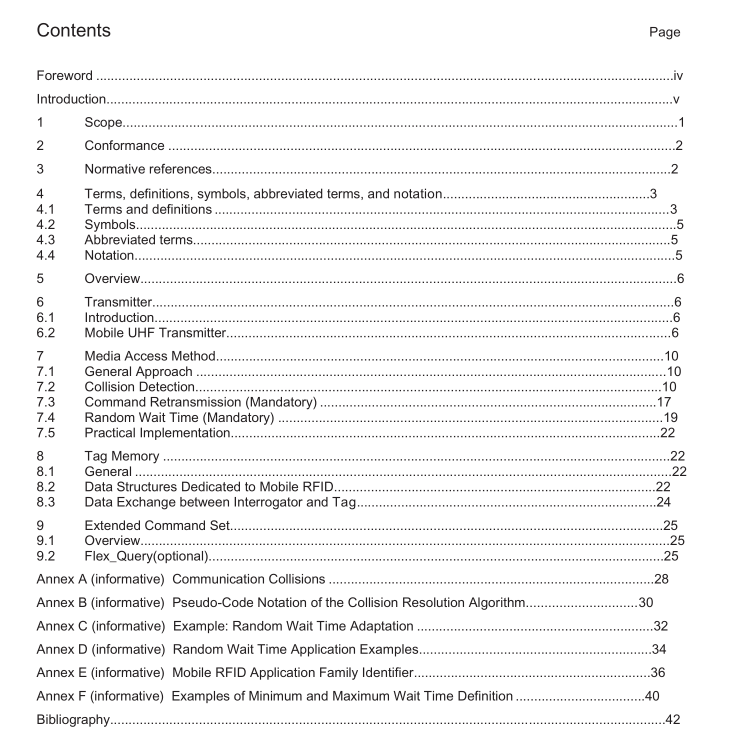BS ISO IEC 29143 pdf download

BS ISO IEC 29143 pdf download Information technology — Automatic identification and data capture techniques — Air interface specification for Mobile RFID interrogators
1 Scope
This International Standard applies to Mobile radio frequency identification (RFID) interrogator devices used toinventory passive or semi-passive backscatter tags at 860 MHz to 960 MHz in a mobile (non-fixed) applicationindependent from specific communication details, i.e. modulation technique and command set.
Furthermore,the scope of this International Standard is mobile consumer applications, whereas mobileenterprise applications are not covered as long as operating in a closed environment.
An operating environment is considered to be closed if it belongs to a central administrative authority able toguarantee for sufficient isolation, i.e. preventing mobile enterprise interrogator devices from being usedoutside the dedicated operating environment,and if sufficient spatial separation and/or electromagneticshielding from adjacent operating environments is provided.
An application is considered a consumer application if at least one of two interacting entities is a privateindividual (consumer) and the interaction is taking place in the public domain.Consequently, a Mobile RFIDconsumer application is defined as Mobile RFID equipment (e.g. mobile phones equipped with an RFIDinterrogator) being used in a consumer application.
NOTE
As there is currently no active contribution on Mobile HF interrogators, this International Standard covers only
UHF.
This International Standard specifies
-Mobile RFID interrogator media access control,
– interrogator to interrogator and multiple interrogator to tag collision arbitration scheme including
interrogator requirements,
– interrogator to interrogator and multiple interrogator to tag collision avoidance scheme, and- tag memory use for Mobile RFID applications.
This lnternational Standard does not specify
– physical interactions (the signaling layer of the communication link) between interrogators and tags,- interrogator and tag operating procedures and commands, and
– the collision arbitration algorithm used to singulate (separate to the current response slot) a specific tag in
a multiple-tag environment.
NOTE These aspects are addressed by other International Standards.
ln particular, this Intermational Standard does not replace any existing RFID air interface specification issuedby lISOnEC but extends the existing methodologies for fixed RFID interrogators with mechanisms addressing the special challenges of Mobile RFID. The concepts and mechanisms described in this International Standard can be integrated in any existing RFID protocol approved by ISO/IEC for the given frequency range of 860 MHz to 960 MHz (unless explicitly prohibited by such protocol) regardless of the actual command set. The mechanisms defined by this International Standard can be used for Mobile RFID interrogators used in consumer applications and compliant to ISO/IEC 18000-6.
2 Conformance To claim conformance with this International Standard, an interrogator shall comply with all relevant clauses, except those marked as “optional”. Moreover, the interrogator shall also operate within local radio regulations, which may further restrict operation. To claim conformance with this International Standard, an interrogator shall also fulfill all requirements to claim conformance with the basic air interface specification ISO/IEC 18000-6. NOTE The basic assumption is that this International Standard cannot be used standalone. It is not intended to encourage usage of a proprietary air interface in combination with the extension defined in this International Standard and allow claiming conformance with this International Standard in that context.
Mobility of the RFID interrogator device is not a requirement for claiming conformance with this International Standard. It is recommended that all RFID interrogators operating in public areas of service, where interrogator to interrogator and multiple interrogators to tag collisions cannot be ruled out by administrative measures such as Time Division Multiplexing or Frequency Division Multiplexing, support the mechanisms specified in this International Standard regardless of the particular usage of the device (fixed, mobile, or both). Conformance may also require a license from the owner of any intellectual property utilized by this device. A mobile device shall only activate its RF for RFID capabilities if it is established that it operates according to the RF regulations of the country where it is turned on. For mobile phones this implies that the phone shall derive the country of operation from the network before activating the RF capabilities for RFID.
3 Normative references
The following referenced documents are indispensable for the application of this document. For dated references, only the edition cited applies.
For undated references, the latest edition of the referenced document (including any amendments) applies. ISO/IEC 18000-6:2010, Information technology — Radio frequency identification for item management — Part 6: Parameters for air interface communications at 860 MHz to 960 MHz ISO/IEC 19762 (all parts), Information technology — Automatic identification and data capture (AIDC) techniques — Harmonized vocabulary RFC 2141, URN Syntax, May 1997 RFC 3406, Uniform Resource Names (URN) Namespace Definition Mechanisms, October 2002









